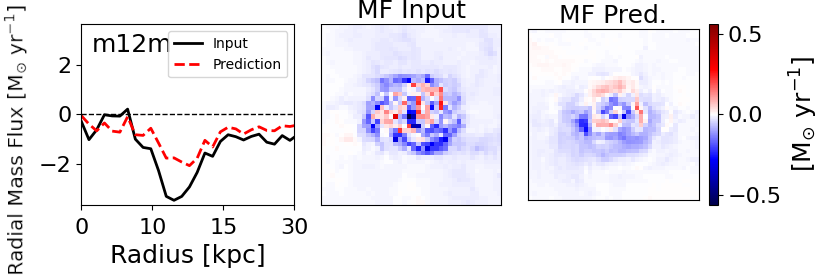Cameron Trapp
About Me
I’m Cameron Trapp, a Postdoc in the Physics & Astronomy Department at Johns Hopkins University working in the the FOGGIE collaboration.
I recently completed my PhD in collaboration with Prof. Dušan Kereš at the University of California, San Diego. My doctoral research focused on analyzing gas flows onto and through Milky-Way mass galactic disks utilizing cosmological zoom-in simulations as part of the Feedback in Realistic Environments (FIRE) collaboration. In addition, I analyzed various sources of Torque on this accreting gas to understand how it radially transports to fuel star forming regions in the inner disk. I am also working on creating a suite of synthetic HI observations in order to train convolutional neural networks to aid in interpretation of observations and facilitate direct observational comparisons.
In addition to research, I ran the Young Physicists Program (YPP), an outreach organization that engages middle and high schoolers in actual physics experiments. Students are able to work directly with a variety of experiments, including mechanics, circuits, radioactive decay, and the infamous egg drop. In addition to managing/soliciting volunteer graduate students and professors, I work directly with the students during experiments and more advanced demonstrations.
In my spare time I enjoy hiking and camping, as well as designing video games in Unity and Unreal Engine 5.
Research
Radial Flows of Gas

Observations indicate that a continuous supply of gas is needed to maintain observed star formation rates in large, disky galaxies. To fuel star formation, gas must reach the inner regions of such galaxies. Despite its crucial importance for galaxy evolution, how and where gas joins galaxies is poorly constrained observationally and rarely explored in fully cosmological simulations. To investigate gas accretion in the vicinity of galaxies at low redshift, we analyzed the FIRE-2 cosmological zoom-in simulations for 4 Milky Way mass galaxies, focusing on simulations with cosmic ray physics. We found that near present times, gas approaches the disk with angular momentum similar to the gaseous disk edge with an average velocity of 10-20 km/s, piling-up near the edge and settling into full rotational support. Accreting gas moves predominantly parallel to the disk and joins largely in the outskirts. Immediately prior to joining the disk, trajectories briefly become more vertical on average. Within the disk, gas motion is more complex, being dominated by spiral arm induced oscillations and feedback. However, time and azimuthal averages show slow net radial infall with transport speeds of 1-3 km/s and net mass fluxes through the disk of M_Solar/yr , comparable to the galaxies’ star formation rates and decreasing towards galactic center as gas is sunk into star formation.
Torques and Angular Momentum Transfer
A natural follow up to our previous study on how gas moves onto and through Milky-way like galaxies is to investigate the physical mechanisms that are driving these flows. To accomplish this, we need to dive into the various sources of torques in our simulations to understand where the angular momentum is being transferred to allow this gas to move radially inwards. To this effect, we modified the FIRE-2 CR+ code used in our previous study to track and output various sources of torque, including gravitational torques, MHD torques associated with the Riemann Solver, torques arising from forces do to radiative transfer, as well as torques from the direct momentum injection of stellar feedback, including supernovae and stellar winds. We ultimately found a complex interaction in these gas flows, predominantly governed by the gravitational and hydrodynamical torques, with the torques from supernovae playing an interesting role as well. Ultimately, the hydrodynamical torques serve to transfer angular momentum from the outer disk, allowing this gas to move radially inwards and fuel star formation. This angular momentum is either transferred outside of the disk via pressure torques, or to the interior regions of the disk via the mass flux terms in the hydro solver. Once in these regions, the dark matter halo and stellar structures are able to more efficiently act as a sink for angular momentum through gravitational torques, allowing for a net inflow of gas in the system.
Synthetic Observations and Machine Learning

While we find overall consistency of our results and observational constraints, more detailed comparisons are needed to test the underlying model. Our current directions focus on making synthetic HI observations of our simulated galaxies for more direct comparisons of how these inflow signatures may observationally manifest and ultimately aid in the interpretation of observational data. While standard Tilted Ring Models have been used to estimate gas motion in galaxies for decades, the complex radial velocity structures seen within our galaxies, coupled with the relatively low azimuthally averaged velocities would prove difficult to fit. To overcome this, we designed a 3-D Convolutional U-Net that reads in the full spectral data cube of HI observations and outputs a corresponding 2D map of Radial Mass Flux. The neural network has currently been trained on 20 different galaxies from the core FIRE-2 runs, as well as the CR+ runs. A synthetic image was generated for 10 snapshots for each galaxy, each at 6 different inclinations for a total of 1200 images. When applied to actual HI data with stable Tilted Ring fits, our network is able to reproduce the radial mass flux curves. Future directions for this project include adding in additional simulation suites to the training set, so as not to be overly biased towards the types of galaxies in the FIRE simulations, fitting additional parameters, and fitting 3D spatial maps to visualize observed galaxies.
Publications
First Author Publications
Angular momentum transfer in cosmological simulations of Milky Way-mass discs
Gas infall and radial transport in cosmological simulations of Milky Way-mass discs
On the detection of high frequency correlations in resting state fMRI
Additional Publications
The impact of cosmic rays on dynamical balance and disc–halo interaction in L-star disc galaxies
Hot-mode accretion and the physics of thin-disc galaxy formation
Contact
Department of Physics and Astronomy
Johns Hopkins University
3400 N. Charles Street
Baltimore, MD 21218
ctrapp2 [at] jh [dot] edu

